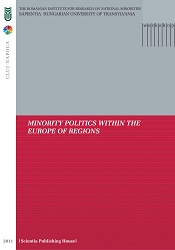A History of Collective Minority Rights in the European Historical Context
A History of Collective Minority Rights in the European Historical Context
Author(s): Pieter Van der Plank
Subject(s): Politics / Political Sciences, Law, Constitution, Jurisprudence, Human Rights and Humanitarian Law
Published by: Scientia Kiadó
Keywords: autonomy;Enlightenment;collective rights; Kulturkampf; Universal Declaration of Human Rights
Summary/Abstract: Autonomy was a traditional solution that state and church authorities implemented to solve the problems of ethnic diversity predominantly represented by religious denominations. Although the 17th century Ancien Régimes generally used compulsion and violence to maintain homogeneity among the objects of their sovereignty, in the run of the 18th century, this policy was no longer a guarantee for stability and control. Shifting political boundaries too often brought dissident denominations under the control of states dedicated to other (state) religions. The Age of Enlightenment would no longer accept traditional solutions of converting and expelling minorities, and granted particular privileges, in other words, collective rights, in order to control such minorities by juridical isolation. In the 19th century, collective rights were no longer acceptable in unitary democratic states. Because their citizens emancipated from objects of the sovereign to subjects of the state, they had to become individuals equal in rights and living together under the same laws. In Western Europe, a so-called Kulturkampf (culture struggle) was necessary to secure the predominance of the state over the (Roman Catholic) Church, restricting her jurisdiction. So, the national democratic concept became successful in mononational Western European states. In East-Central Europe, it could not be implemented without a severe threat to the integrity of the multinationally composed states: Russia, Austria-Hungary, and the Ottoman Empire. Here, national dissident emancipation was fostered by strongholds in religious denominations and organisations. Anyway, the great powers had to cope with growing and centrifugal national separatist movements among their citizens. Each of them tried to solve this problem in different and often reactive and repressive ways, and none of them succeeded. Austria tried in vain to work out compromises between personal, collective, and territorial rights. In this respect, important contributions were made by social democrats (Renner and Bauer) with the aim to reconcile old collective and new individual rights in a territorial solution. But besides an interesting implementation of their ideas in the crown provinces of Moravia and Bucovina, an outspoken nationalism dominated the discourse in other provinces, paralysing any further debate and the development of a tolerant and liberal climate. The collapse of the multinational great powers in WW I gave way to the political reorganisation of Central Europe in some seven new nationstates founded by the Peace-Treaties of Paris on the confusing basic principle of the international law: the Peoples’ Right of Self-determination. Although this right was a collective one, giving a people sovereignty as a nation was implemented in states inhabited not only by such a nation but also by large national dissident minorities, mounting up to thirty million Central Europeans. State citizenship proved to be a weak concept in the new nation-states. They were not able, and most of them also not willing, to work out a compromise between constitutionally guaranteed individual rights of their citizen subjects and the need of collective rights by those citizens belonging to minority groups willing to maintain a social and cultural life of their own. Since then, religious as well as national provisions of minorities have deteriorated under state jurisdiction, becoming play things in the hands of politicians. In the last years before the outbreak of WW II, the Axis Powers in co-operation with the Soviet Union provoked and forced large-scale territorial annexations as a correction upon the peace-treaties, making the fear for irridenti real. Even new national (puppet) states were erected for nations who formerly had not received recognition in the peace-treaties. These territorial solutions could only solve the old minority problems by creating new ones. Ethnic cleansing was carried out to enforce national homogeneity within the new boundaries. Jewish minorities were eliminated by genocide. In German-occupied territories, German-speaking minorities were privileged by a collective status. In agreement with the state authorities of the Axis-confederates, some and in particular also these germanophone minorities got a bi-national status, and finally had to accept German nationality exclusively. These constitutional distortions discredited collective minority status as a solution. After the war, the victorious Allied Powers considered the existence of minorities to have been a war cause in the hands of the Axis Powers and their confederates, and collective minority rights still to be a source of severe international troubles for the future. They not only decided to return to the pre-war state boundaries (with the exception of the annexations by the Soviet Union) but also to accept and even guide massive national cleansing of the population within these boundaries. The Universal Declaration of Human Rights reflects this juridical reenforcement of the individual citizen, but in a new quality: as a sovereign human subject of a state. The date of the proclamation can hardly be coincidental: December 1948, just after three years of the massive and forceful replacing of some twenty million Central Europeans just because of an unwanted ethnic or national identity. Since then, in the Soviet-controlled parts of Europe, minority problems were marginalised in bureaucratic regulation. The socialist peoples’ republics implemented an ideological solution of these problems, making individual rights unnecessary and collective rights unlawful. Only one territorial experiment – the autonomous Szekler region in Romania – had a short and unhappy life. In 1990, a new era would start, giving new perspectives to minority rights within the framework of a European legislature. And, covered by this jurisdiction, national minorities should no longer be a threat to the integrity of a modern European state. Nevertheless, anachronistic reflexes still continue to define and (mis)use their existential need for collective rights as such.
Book: MINORITY POLITICS WITHIN THE EUROPE OF REGIONS
- Page Range: 393-411
- Page Count: 19
- Publication Year: 2011
- Language: English
- Content File-PDF

